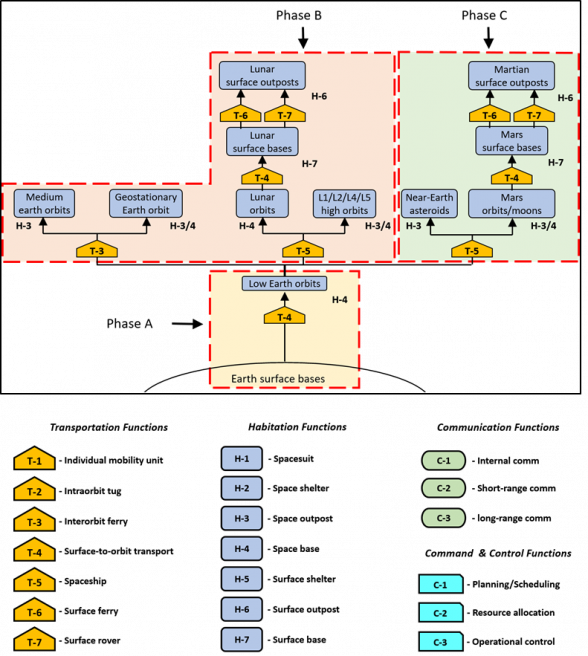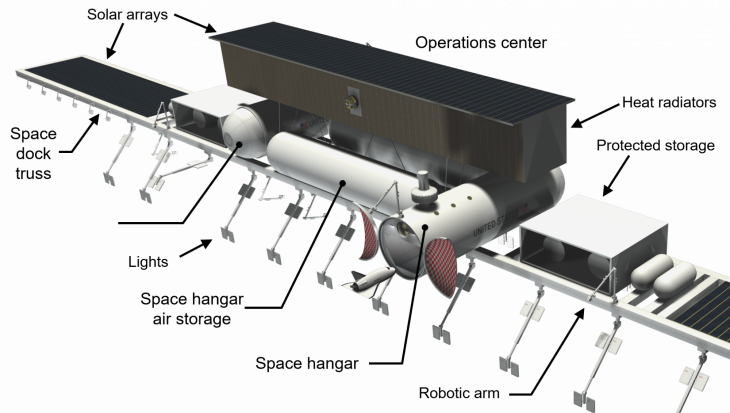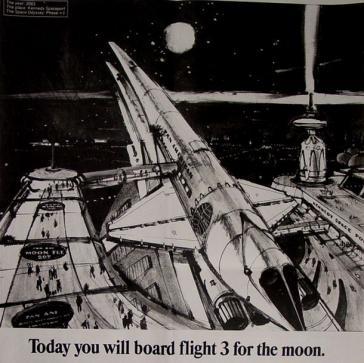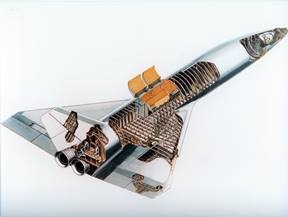INTRODUCTION
When addressing the National Space Council on June 18, 2018, President Trump made clear his spacefaring vision for America when he said: “My administration is reclaiming America’s heritage as the world’s greatest spacefaring nation.” He went on to state his desire to establish a new sixth branch of the armed forces—the U.S. Space Force. At the August 13, 2018 signing of the 2019 National Defense Authorization Act, the President stated, “In order to maintain America’s military supremacy, we must always be on the cutting edge. … Just like the air, the land, the sea, space has become a warfighting domain. We must have American dominance in space.” Achieving this dominance will require developing not only new military space systems but spacefaring logistics to deploy and sustain forward-deployed personnel and systems during times of peace and conflict.
Terrestrial logistics capabilities supporting forward deployed American forces have civil (e.g., ports), commercial (e.g., passenger and cargo transport), and military components. Military materiel acquirers and logistics planners will need to provide comparable spacefaring logistics capabilities to support U.S. military personnel and capabilities forward deployed to space. It is difficult to conceive of a U.S. Space Force (and a U.S. Space Guard) having effective operational capabilities in space absent such spacefaring logistics capabilities. Hence, establishing an American spacefaring logistics infrastructure is essential for executing the President’s charge to “have American dominance in space” and return America to being “the world’s greatest spacefaring nation.” What will come as a surprise is that America’s aerospace industry now has the industrial mastery to develop and start deploying the needed civil–commercial–military spacefaring logistics infrastructure.
SPACEFARING LOGISTICS CAPABILITIES
Drawing upon the definition of military logistics, spacefaring logistics can be defined as follows:
Spacefaring logistics is the science of planning and carrying out the movement of humans and materiel to, from, and within space combined with the ability to maintain human and robotic operations in space. In its most comprehensive sense, spacefaring logistics addresses the aspects of spacefaring operations both on the Earth and in space that deal with:
- Design and development, acquisition, storage, movement, distribution, maintenance, evacuation, and disposition of spacefaring materiel;
- Movement, evacuation, and hospitalization of people in space;
- Acquisition or construction, maintenance, operation, and disposition of facilities on the Earth and in space to support human and robotics space operations; and
- Acquisition or furnishing of services to support human and robotics space operations.
Note: This definition was originally developed by the Space Logistics Technical Committee of the American Institute of Aeronautics and Astronautics.
Going back to the founding of the United States, building national logistics infrastructure was undertaken to promote commerce and military defense. Transforming America into a true spacefaring nation will require national investments in a spacefaring logistics (hereafter referred to as “astrologistics”) infrastructure supporting civil, commercial, military, and, eventually, private users.
Establishing this new infrastructure will require updated and new capabilities. These capabilities will include transportation to, from, and within space and on the Moon and Mars; human habitation facilities in space and on the Moon and Mars; and associated communication and command and control capabilities.
The habitation and transportation functional architecture of such an astrologistics infrastructure [1], as shown in Figure 1, could be deployed in three phases:
- Phase A: Accessing low Earth orbit (LEO) regularly and safely and creating the initial shared LEO astrologistics infrastructure.
- Phase B: Expanding the LEO common astrologistics infrastructure and extending this to medium and geostationary Earth orbits (GEOs), the Earth-Moon LaGrange orbits, lunar orbit, and the lunar surface.
- Phase C: Extending the common astrologistics infrastructure to support human and robotic exploration of Mars, near-Earth asteroids, and throughout Earth-Mars space.
Phase A of the infrastructure buildout will regularize government and commercial human transport to LEO and establish the initial permanent logistics operations in LEO. These shared facilities, similar to how many large U.S. airports are shared, will enable the initial forward deployment of U.S. Space Force/Space Guard personnel and materiel while also enabling expanded commercial and scientific operations. The Phase B expansion will support U.S. Space Force operational capabilities to protect and defend vital U.S. commercial and military space capabilities and expand the protection of the United States and its allies from attacks through or from space. Phase B will also support the permanent return of Americans to the Moon and enable a U.S. Space Guard to exert U.S. legal authority and render assistance to U.S. government, commercial, and private operations throughout Earth-Moon space. Phase C will support the American human exploration of Mars and potential future U.S. commercial operations to mine asteroids for natural resources needed by an expanding American space enterprise.

BUILDING SUBSTANTIAL LEO HABITATS
Nearly 70 years ago, Robert A. Heinlein, an early author of “hard” science fiction stories, stated, “Get to low-earth orbit and you’re halfway to anywhere in the solar system” [2]. Heinlein was referring to rocket ships using chemical propulsion—a limitation that is still present when developing non-nuclear space launch systems. For this reason, Phase A requires establishing logistics facilities in LEO to receive and house personnel and materiel transported from Earth and enable commercial and military space operations. Obviously, the new facilities will need to be substantial to support a permanent American spacefaring presence, including, for example, a U.S. Space Guard, space-mining operations, and a growing space tourism industry.
The United States built two facilities in LEO—the Skylab Space Station and the International Space Station (ISS). The method used to deploy these two space stations substantially influenced their design.
During the 1960s Apollo program, NASA’s contractors began designing a space station to deploy using the immense Saturn V rocket. Called Skylab, the final design was a space station fabricated from a modified Saturn V third-stage hydrogen propellant tank (see Figure 2). This enabled the entire space station to launch into orbit using a single launch. Within a matter of hours after the arrival of the crew, launched separately, the station was operational. When launched in 1973, Skylab provided 350 m3 of habitable volume for a crew of three—equal to the volume of a 1,500 ft2 home or 117 m3 per person. It demonstrated the value of assembling space stations using large modules having ample internal volume to move around.
NASA is planning to use the new Saturn V-class rocket to restart human space exploration missions and launch large space probes to distant parts of the solar system.
![Figure 2: Saturn V Launch Vehicle Used to Launch the Skylab Space Station and Skylab Cutaway Illustration (Source: National Aeronautics and Space Administration [NASA]).](/wp-content/uploads/2019/11/dsiacjournal_winter2019_spacefaring_snead_fig2-712x555.png)
In contrast, the ISS was assembled from smaller modules. Its assembly required 27 Space Shuttle missions along with multiple Russian and American unmanned launches. The ISS currently has about 1,000 m3 of pressurized volume for a maximum crew of six—about 167 m3 per person.
Today, NASA is completing development of a new Saturn V-class rocket—the Space Launch System (SLS) (see Figure 3). First conceived in the 1990s as a derivative of the Space Shuttle, NASA is planning to use it to restart human space exploration missions beyond LEO and launch large space probes to distant parts of the solar system. As the 1973 launch of the Skylab demonstrated, an unmanned version of the SLS can be used to place large habitation modules into LEO.

At the Michoud Assembly Facility outside New Orleans, where the 8.3-m diameter SLS core is now being built, habitation modules up to 10-m (33-ft) diameter x 30 m (100 ft) long could be built as SLS payloads. Figure 4 illustrates a LEO space base using two module designs—one 8.3-m diameter operations module and two 10-m diameter hangar modules [3]. This space base would be an H-4 habitat shown in Phase A of Figure 1.

In the 1960s, when NASA was first conceptualizing the design of Skylab, one idea considered was to reuse the propellant tanks of the rocket on orbit for pressurized habitation. During the early years of the Space Shuttle program, reusing the external tank in this manner was also evaluated. The LEO space base would require three SLS missions providing three sets of SLS core propellant tanks. Two of these sets—those launching the two hangar modules—would be incorporated into the base to store air when the hangars are depressurized. These repurposed tanks would be positioned between the two hangars. A truss would provide the structural foundation for assembling the base. The truss would also serve as a space dock for assembling and supporting other habitats and space vehicles. Lights along the truss would provide illumination when the underside of the base is in shadow.
The third SLS core would remain attached to its payload—the operations module. The operations module would be fabricated using a modified SLS core hydrogen tank. With the retained SLS core converted into simple, pressurized habitation for crew quarters, recreation, and training, the total pressurized volume would be approximately 5,000 m3—suitable for a crew size of about 25 at 200 m3 per person.
An ISS-style airlock enables personnel access to space.
The space base incorporates two space hangars to provide assembly, servicing, repair, and training capabilities needed for routine spacefaring operations (see Figure 5). Except for the airlock and the interior compartments, each space hangar would launch as a single SLS payload. The outer space doors and the outer protective wrap protect against micrometeoroid and small debris impact and help regulate the temperature in the hangar. An ISS-style airlock enables personnel access to space. Cargo modules and space vehicles brought into the hangar are first secured on the retractable cargo floor. The main hangar deck and the spherical work bay can be separately depressurized. The maintenance compartments provide bench-level diagnostics and repair. Access tunnels connect the compartments to the operations center attached above the two hangars. A lower access tunnel provides access to space vehicles assembled and serviced at the space dock (see Figure 6).


With design forethought, the basic operations module and hangars can be used to assemble other space facilities and spaceships. For example, the spaceship shown in Figure 6 incorporates a version of the space hangar to enable astrologistical operations at other locations, such as servicing lunar landers while in lunar orbit.
By using a hub and spoke design, where the hangars are incorporated into the hub and modified operations modules are used as spokes, substantial habitats can be assembled. Figure 7 shows a basic habitat, with four spokes assembled at the space dock [4]. This configuration would require seven SLS missions—four for the spokes and three for the hub. An expanded configuration with 12 spokes is also shown. (Note: A video showing these concepts is available at https://www.youtube.com/watch?v=9Xu0-UrFInQ&feature=youtu.be.)
This hub-spoke design enables the habitat to rotate about the hub to produce artificial gravity in the spokes. As shown in the cutaway illustration in Figure 7, the spoke would be divided into 14 useable floors. Each floor would be about 8 m in diameter, with about 42 m2 of useable floor area. Each spoke would have 588 m2 of floor area. The basic four-spoke configuration, housing about 100 people, would have 2,352 m2 (25,317 ft2) of floor area, with substantial, additional useful volume in the hub. The 12-spoke configuration, with 7,056 m2 (75,951 ft2) of floor area, could accommodate about 300 people.

Human logistics systems function best in a gravity environment. This enables conventional food preparation, bathroom operations, medical procedures, and housekeeping services and eases cleaning up spills and messes. Rotating the habitat at two revolutions per minute will create a variable gravity environment from near zero-g, where the spoke attaches to the hub, to Mars gravity at the outer floor. Most human operations will occur in the outer floors, where the gravity ranges from that of the Moon to that of Mars. This provides an environment for experimentation of biological and mechanical systems operations at lunar and Martian gravity levels.
AIRCRAFT-LIKE, EARTH-TO-ORBIT TRANSPORTATION
NASA’s “Commercial Crew” program will reinstate American human space access using 1960s-style space capsules. In addition to transporting NASA astronauts to the International Space Station, these can provide an initial human transport capability while building the LEO space base. However, as the base becomes operational and expansion of human operations in LEO and beyond is undertaken, “aircraft-like access to space” must be provided using new capabilities.
The United States has pursued aircraft-like access to space starting with the first aerospaceplane studies in the late 1950s. Stanley Kubrick’s 1968 movie “2001: A Space Odyssey” portrayed a two-stage-to-orbit (TSTO) spaceplane for transporting passengers to LEO (see Figure 8). When NASA first developed the Space Shuttle in 1970, it was first envisioned as a TSTO system. Due to technology, policy, and budget considerations, a partially-reusable design was adopted. In the late 1970s, Boeing developed a quasi single-stage-to-orbit (SSTO) design, called the Reusable Aerodynamic Space Vehicle (RASV), that used a sled to assist takeoff. Boeing proposed to build a prototype of it for the federal government at a cost of $1.4 billion (see Figure 9).


Responding to the development of new technologies from NASA’s Space Shuttle program (e.g., reusable rocket engines, thermal protection, and propellant tanks) and Boeing’s expression of confidence in building a spaceplane, the U.S. Air Force renewed its studies of manned space access systems. At the Air Force Aeronautical Systems Division (ASD) at Wright-Patterson Air Force Base, Ohio, the Transatmospheric Vehicle (TAV) Project Office was established in 1983. Major airframe companies were placed under contract to prepare TAV concepts. Several quasi-SSTO and TSTO concepts were proposed, including the RASV. After evaluation, the TAV Project Office selected a Boeing TSTO design to use as the baseline for further technology readiness and mission assessments (see Figure 10).

This TSTO TAV concept would take off and land on a runway. As shown in Figure 10, mating the second-stage orbiter to the first-stage carrier aircraft only requires a standard aircraft tug. Once mated and fueled, the TAV takes off under jet power, climbing to its cruise altitude of 30,000 ft. At the appropriate location, modified Space Shuttle main engines (now referred to as the RS-25) on the first and second stages are turned on. The TAV performs a zoom climb to 103,000 ft, where the orbiter separates from the carrier aircraft. While the carrier aircraft returns and lands at the base, the orbiter continues to LEO. When its mission is completed, the orbiter reenters and lands unpowered, just like the Space Shuttle orbiter. Shown in Figure 11, the TAV orbiter is similar in overall size to the Space Shuttle orbiter. An unmanned cargo version and a crewed passenger version of the orbiter would most likely be developed, providing the T-4 transportation function shown in Phase A of Figure 1.
In early 1985, the TAV Project Office completed its formal mission analyses and technology readiness assessment. The assessment was done per the criteria defined by an Air Force General Officer steering group formed to oversee the TAV studies, as this was expected to become a major acquisition program like the B-2, C-17, and F-22 underway at ASD. Based on the assessment’s favorable results, ASD formally recommended starting full-scale development of a TSTO TAV system. This would have led to an operational, manned spaceflight capability in the late 1990s. While this recommendation was not pursued by the Air Force, for over 30 years, America’s aerospace industry has had the industrial mastery necessary to undertake developing fully-reusable TSTO TAVs capable of aircraft-like access to space.
America’s aerospace industry has had the industrial mastery necessary to undertake developing fully-reusable TSTO TAVs capable of aircraft-like access to space.
What is particularly important to understand is that the Air Force only operates aircraft that have been airworthiness certified—unlike the Space Shuttle or the current NASA Commercial Crew system. If a TSTO TAV had been developed, it would have met these airworthiness requirements. Airworthiness focuses on safety rather than how the vehicle is configured. In the early 1950s, Boeing developed the jet-powered KC-135 tanker for the Air Force, enabling Boeing to develop the Boeing 707 commercial airliner. Along with the Douglas DC-8, these two jet airliners jumpstarted the commercial jet age. Had the Air Force pursued a TSTO TAV in the late 1980s and early 1990s, a commercial variant could have possibly been operating in the early 2000s. Like the military TAV, the commercial TAVs would have been airworthiness certified as required for commercial passenger transport.
CONCLUSION
Developing TSTO TAVs, perhaps using Boeing’s concept, will enable the United States to quickly develop aircraft-like access to space to support expanded civil, commercial, and military operations in space. When combined with using the SLS to build large LEO bases, habitats, and other needed capabilities, such as fuel depots, America can quickly take impressive steps to reclaim “America’s heritage as the world’s greatest spacefaring nation.”
References:
- Snead, J. M. “Space Infrastructure Planning.” Presented at Space 96: The 5th International Conference/Exposition on Engineering, Construction, Operations, and Business in Space; American Society of Civil Engineers, Albuquerque, NM, 1–6 June 1995.
- Stine, G. H. “Halfway to Anywhere: Achieving America’s Destiny in Space.” New York: M. Evans and Company, Inc., 1996.
- Snead, J. M. “Architecting Rapid Growth in Space Logistics Capabilities.” AIAA Joint Propulsion Conference, July 2004.
- Snead, J. M. “Building Large Space Bases in Low Earth Orbit.” Presented at Space 96: The 5th International Conference/Exposition on Engineering, Construction, Operations, and Business in Space; American Society of Civil Engineers, Albuquerque, NM, 1–6 June 1995.



![Figure 11: The Boeing TSTO TAV Orbiter (Sources: [Top] Boeing and [Bottom] J.M. Snead).](/wp-content/uploads/2019/11/dsiacjournal_winter2019_spacefaring_snead_fig11-763x431.png)